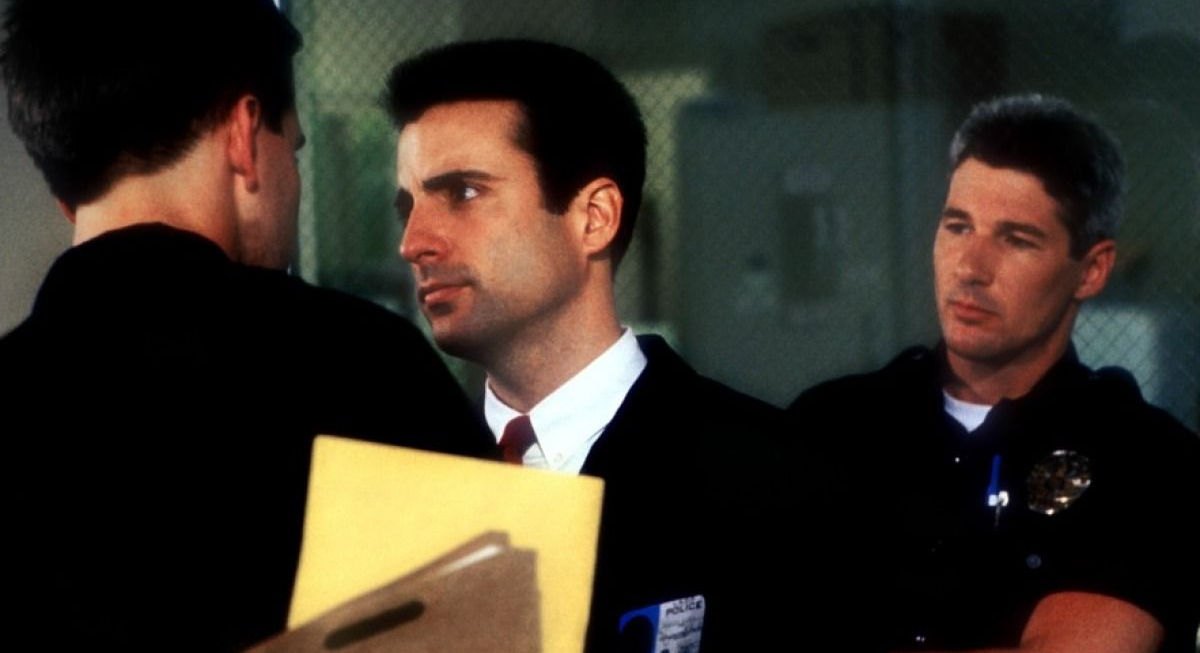
Andy Garcia and Richard Gere in Internal Affairs.
Internal Affairs (1990) at first appears poised to be a refreshing anomaly in the cop-thriller genre — a movie just as much interested in offering pulpy fun as criticism. It seems specifically intent on narrowing in on how endemic corruption can become in powerful institutions like law enforcement, and how significant the ramifications can be the longer it goes unchecked. But eventually, the film, which is set in the early-1990s L.A. police milieu, becomes simplistic, ideologically confusing. It trades its once-promising feeling of naturalism and focused acrimony for character-driven messiness that makes its ethical stances (and ideas about what kind of movie it wants to be in general) ultimately unclear. The one-time persuasively unscrupulous veteran cop at the center of it all (Richard Gere) becomes increasingly bad in an incoherent way. By the movie’s end he’s gone from probable antagonist to Disney villain in a movie for adults. After a while, the internal-affairs agent pursuing him (Andy Garcia) seems less concerned about perpetuated sins and more with a personal thirst for revenge. On paper this sounds like an interesting development — a test of how one’s value system can change when their skin is suddenly in the game. But the film portrays it so broadly that we’re unconvinced by it.
The Gere character, salt-and-peppered Dennis Peck, starts the film textbook amoral. He plants evidence, makes deals with criminals, romances the spouses of co-workers. He has a bunch of ex-wives and eight kids, with a ninth on the way. Characters wonder how he supports them all on his salary. The Garcia character, comically no-nonsense Raymond Avila, seems close enough to a stand-up guy in the classic-Hollywood mold. He’s humorless because he can’t laugh when he smells corruption in the air. When he’s brought in at the beginning of the film to investigate a puzzlingly reported drug bust “resolved” by Peck and his cocaine-addicted, domestically abusive partner Van Stretch (William Baldwin), he, as it probably goes with all his other gigs, gets all one-track minded. He stops paying attention to his wife, Kathy (Nancy Travis), who works in the art world. (Though he gets along with his smart partner Amy Wallace (Laurie Metcalf), the film’s best character.)
Early scenes in the movie are efficient. They’re able and entertaining rehashes of the age-old good-cop/bad-cop dichotomy, and come with what feel like cogent police-world observations. It’s like watching an inspired primetime-TV procedural. But as the feature progresses it’s less and less interested in maintaining sufficient-enough realism; the environment it shows starts to lose believability. Van Stretch is clearly addicted to drugs and even casually drops the N-word during a standard meeting with Wallace and another higher-up, for instance. But he faces no immediate repercussions — it hardly registers. Yet other characters who do far more innocuous things (e.g., a younger officer taking out anger on a piece of office furniture) are immediately dealt with, and harshly.
Perhaps these examples could work together to make a simulacrum. They’re there to say that, in law enforcement, favoritism and leniencies for the more tenured are tentacles that can prop up corruption. But when there are discrepancies like this in the movie, they seem more effects of confused writing than intentional indictments of real-life discrepancies. And once the motivations of the characters take a turn for the melodramatic — like Peck deciding that he’s going to toy with Avila just like other younger officers (by allegedly sleeping with Kathy) with no real outcome in mind, like Avila deciding to get extra aggressive in his bringing Peck to justice because of the wife thing rather than the corruption thing — the movie wanders and further loses sight of its own ethical sense. Late in the film, Avila verbally humiliates and then hits Nancy in a restaurant. The film treats this as an excusable explosion; it doesn’t address it further. As the film starts to get more “personal,” the more bloated and improbable it gets.
Internal Affairs is reminiscent of William Friedkin’s deranged crooked-cop actioner To Live and Die in L.A. (1985), which was about a secret-service agent (William Petersen) who bends the law to his whims — with growing craze — to avenge the violent death of his partner. What that film got right, as far as indictment-driven police thrillers go, was that it emphasized that basically everyone in it was unprincipled and abusive of their powers. It doubled as a horror movie. Internal Affairs, by contrast, doesn’t untangle the thorniness of its moral complications. It I think unintentionally says that corner-cutting is OK as long it’s putting a stop to worse corner-cutting. How did we get from a potentially sharp, polemical police thriller to this? Internal Affairs progressively loses focus until it’s become a total blur of a movie.